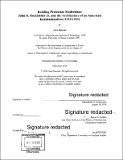| dc.contributor.advisor | Nasser O. Rabbat. | en_US |
| dc.contributor.author | Dawood, Azra | en_US |
| dc.contributor.other | Massachusetts Institute of Technology. Department of Architecture. | en_US |
| dc.date.accessioned | 2019-03-11T19:36:14Z | |
| dc.date.available | 2019-03-11T19:36:14Z | |
| dc.date.copyright | 2018 | en_US |
| dc.date.issued | 2018 | en_US |
| dc.identifier.uri | http://hdl.handle.net/1721.1/120888 | |
| dc.description | Thesis: Ph. D. in Architecture: History and Theory of Architecture, Massachusetts Institute of Technology, Department of Architecture, 2018. | en_US |
| dc.description | Cataloged from PDF version of thesis. Some images were redacted. | en_US |
| dc.description | Includes bibliographical references (pages 698-709). | en_US |
| dc.description.abstract | Following the First World War, American philanthropist and heir to the Standard Oil fortune, John D. Rockefeller Jr., financed an international body of cultural and scientific institutions, which he presented as sites of global "brotherhood," intellectual cooperation, and shared world heritage. Combining religious history with an architectural and urban-spatial analysis of the built environments associated with these institutions, this dissertation argues that Rockefeller's putatively secular and inclusive promotion of culture and science was, in fact, designed to arrest the rise of "savage" nationalisms and a "godless" communism. While scholars have recognized the imperialism inherent in Rockefeller's philanthropy, they have largely ignored its theopolitical dimensions and its unexpected instrumentalization of secular buildings and landscapes towards religious concerns. Focusing on the so-called Orient (which valued modernity, sought freedom from European powers, and understood Western Christianity as an accomplice to imperialism), Rockefeller, a devout capitalist and Baptist, underwrote projects reconciling Christianity with modernity. Simultaneously, he presented Protestant America as a new civilizational leader to diverse audiences, including nationalists in the former Ottoman territories abroad and students from China and other modernizing nations studying in the U.S. Concentrating on two groups of buildings from his larger patronage-the International Student Houses and the museums and archaeological expedition-houses of the University of Chicago's Oriental Institute-I show how Rockefeller leveraged architecture to present an American internationalism and its scientific and religious modernity as a "logical" fit for diverse regions and conditions. From the Pacific Coast to the Middle East, his team of architects, theologians, archaeologists, and social reformers attempted to harmonize each of their buildings within its immediate geopolitical and aesthetic site. I show how Rockefeller's "re-Orientation" of Christianity (and America) coheres these eclectic, geographically dispersed buildings and landscapes into a rational or deliberate oeuvre, and is further revealed in specific erasures and accentuations of the built environment. Finally, this dissertation counters a widespread belief that religion in the modern era is solely contained within explicitly ecclesiastical architecture, or limited to societies "outside" the technoscientific modernity and secular progress of the global North. | en_US |
| dc.description.statementofresponsibility | by Azra Dawood. | en_US |
| dc.format.extent | 709 pages | en_US |
| dc.language.iso | eng | en_US |
| dc.publisher | Massachusetts Institute of Technology | en_US |
| dc.rights | MIT theses are protected by copyright. They may be viewed, downloaded, or printed from this source but further reproduction or distribution in any format is prohibited without written permission. | en_US |
| dc.rights.uri | http://dspace.mit.edu/handle/1721.1/7582 | en_US |
| dc.subject | Architecture. | en_US |
| dc.title | Building protestant modernism : John D. Rockefeller Jr. and the architecture of an American internationalism (1919-1939) | en_US |
| dc.type | Thesis | en_US |
| dc.description.degree | Ph. D. in Architecture: History and Theory of Architecture | en_US |
| dc.contributor.department | Massachusetts Institute of Technology. Department of Architecture | |
| dc.identifier.oclc | 1088726843 | en_US |
